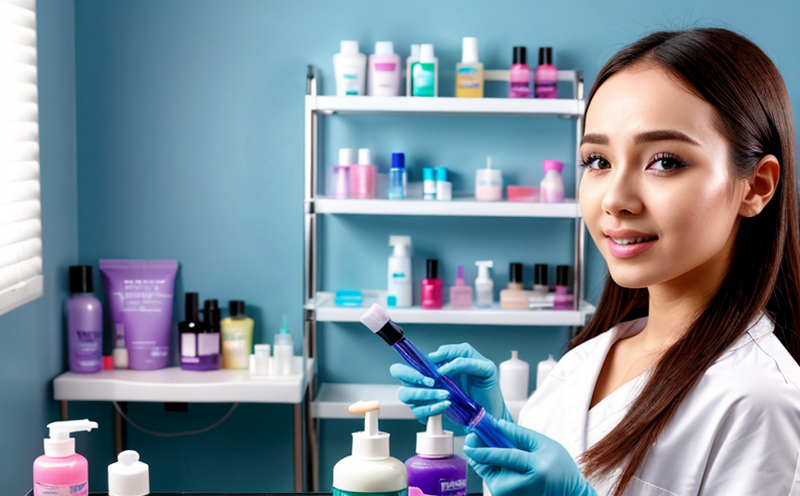EN 1650 Fungicidal Activity Testing in Personal Care Products
The European standard EN 1650 specifies procedures for assessing fungicidal activity in personal care products. This testing is crucial for ensuring the safety and efficacy of cosmetic formulations, particularly those that may come into contact with skin or mucous membranes. Compliance with this standard is essential for manufacturers aiming to meet regulatory requirements set by bodies such as the European Commission.
The procedure outlined in EN 1650 involves exposing fungal spores to different concentrations of the product under controlled conditions. The efficacy of the fungicidal activity is then determined based on the reduction in viable fungal cells after exposure. This test not only helps in validating the antimicrobial properties of a formulation but also supports the development of safer and more effective products.
The standard is particularly relevant for products like shampoos, conditioners, lotions, and other topical applications where prolonged contact with skin or hair can be significant. The results from this testing are critical not only for regulatory compliance but also for brand reputation and consumer trust in the product's safety profile.
For quality managers and R&D engineers, understanding the nuances of EN 1650 is essential. This standard provides a structured approach to evaluating fungicidal activity, which can guide formulation adjustments and ensure that products meet stringent hygiene standards. Compliance officers also benefit from this knowledge as they ensure that all formulations adhere to international standards.
The testing procedure involves several key steps. First, the fungal spores are prepared according to specified protocols. These spores are then exposed to different concentrations of the product under controlled environmental conditions. The exposure time is carefully monitored and adjusted based on the specific fungicidal activity being tested. After the exposure period, the samples are incubated to allow any remaining viable fungi to grow.
The results from this testing are analyzed by comparing the number of viable fungal cells before and after the treatment. This comparison provides a quantitative measure of the fungicidal activity of the product. The acceptance criteria for EN 1650 are based on predefined thresholds that indicate the minimum reduction in viable fungal cells required to be considered effective.
For compliance officers, understanding these parameters is vital as they ensure that all products meet not only regulatory requirements but also internal quality control standards. R&D engineers can use this data to refine formulations and improve product performance. This testing procedure is a cornerstone of ensuring the safety and efficacy of personal care products.
Applied Standards
| Standard | Description |
|---|---|
| EN 1650 | This standard specifies procedures for assessing fungicidal activity in personal care products. It covers the exposure of fungal spores to different concentrations of the product, incubation periods, and methods for determining the reduction in viable fungal cells. |
| ISO 21756 | This international standard provides guidelines for the assessment of fungicidal activity against dermatophytes. It is often used as a complementary test to EN 1650, providing additional data on the effectiveness of antifungal agents. |
| ASTM G21-18 | This American standard outlines procedures for assessing fungicidal activity in paints and coatings. While not directly applicable to personal care products, it provides valuable insights into similar testing methodologies. |
Benefits
The implementation of EN 1650 Fungicidal Activity Testing brings several significant benefits to manufacturers and consumers alike. For manufacturers, this standard ensures that their products are safe for use by the general population. By meeting these stringent standards, companies can build trust with consumers and maintain a positive brand image.
Compliance with EN 1650 also facilitates market access in Europe and other regions where this standard is recognized. It demonstrates commitment to quality and safety, which are critical factors for regulatory bodies such as the European Commission and national health authorities.
For consumers, the assurance of product efficacy and safety provided by EN 1650 testing is invaluable. Knowing that their personal care products have undergone rigorous testing can instill confidence in their purchasing decisions. This transparency also helps to build a loyal customer base.
In addition to regulatory compliance, this testing enhances the overall quality of personal care products. It ensures that formulations are effective against common fungal pathogens while maintaining safety for all users. By adhering to these standards, manufacturers can differentiate their products in a competitive market and offer superior value to consumers.
Industry Applications
EN 1650 Fungicidal Activity Testing is widely used across the personal care industry. Manufacturers of shampoos, conditioners, lotions, and other topical applications rely on this testing to ensure that their products are safe and effective against fungal contaminants.
The procedure is particularly important for formulations that come into direct contact with skin or hair, where prolonged exposure can increase the risk of fungal infections. By incorporating EN 1650 testing into their quality control processes, companies can mitigate these risks and provide safer products to consumers.
In addition to consumer goods, this standard also applies to professional-grade formulations used in medical settings. Hospitals and clinics often use antifungal treatments that are tested according to EN 1650 to ensure they are effective against common fungal pathogens. This ensures that healthcare providers have access to the safest and most efficacious products.
The results from this testing are also valuable for researchers and developers in the personal care industry. They can use these data points to refine formulations, improve product performance, and introduce new innovations into the market. By staying abreast of the latest standards and methodologies, companies can maintain a competitive edge in an ever-evolving industry.





